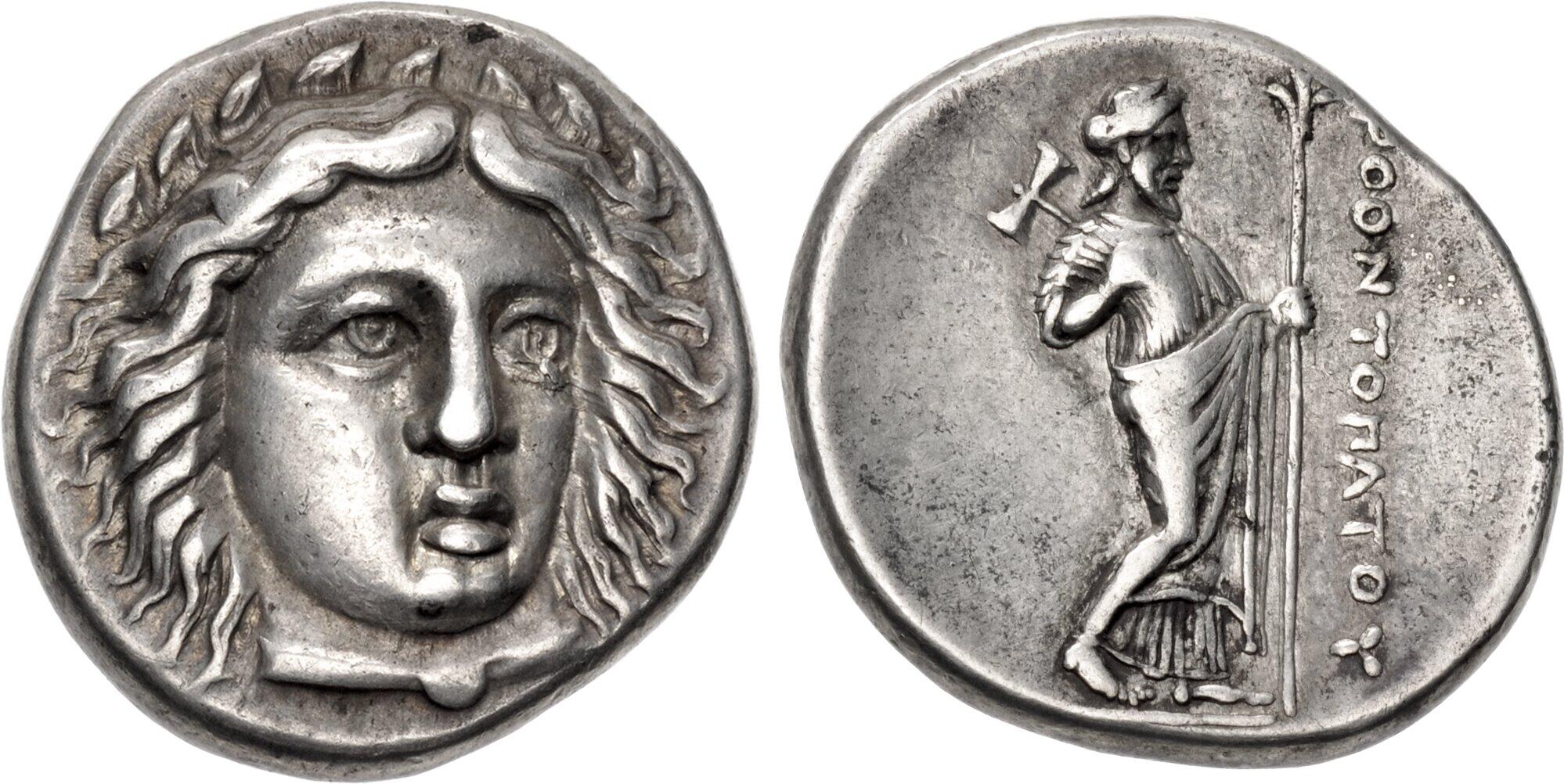AC 257 - Halicarnassus (Rhoontopates) silver, tetradrachms (336-334 BCE)
From SILVER
336 BCE - 334 BCE Silver 3,207 kg
Description
| ObverseInscription or printing placed on the obverse.: | Head of Apollo facing slightly right, wearing laurel wreath and drapery around neck. |
| ReverseInscription or printing placed on the reverse.: | POONTOΠATOY (Greek).Zeus Labraundos standing right, wearing chiton and himation wrapped around the left arm, POONTOΠATOY to right. |
Mint and issuing power
| MintIdentifies the place of manufacture or issue of a numismatic object.: | Halicarnassus | Ancient regionAncient region.: | Caria | Modern countryModern country: Turkey | AuthorityIdentifies the issuing power. The authority can be "pretended" when the name or the portrait of X is on the coin but he/she was not the issuing power. It can also be "uncertain" when there is no mention of X on the coin but he/she was the issuing power according to the historical sources: | Persian Empire, Rhoontopates (satrap of Caria) |
Chronology
| FromIdentifies the initial date in a range assigned in a numismatic context. | 336 BCE | toIdentifies the final date in a range assigned in a numismatic context.. | 334 BCE | PeriodTime period of the numismatic object.: Classical 480-323 BC |
Physical description
| MetalThe physical material (usually metal) from which an object is made.: | Silver |
Median weightMedian of the weights of numismatic objects (in grams). in grams | 15.00 | DenominationTerm indicating the value of a numismatic object. Examples: tetradrachm, chalkous, denarius.: | tetradrachm |
StandardStandard.: |
Image

AC257 Halicarnassus.jpeg [1]
References
| Die study referencePublication of the study: | Konuk 1998b1Konuk 1998b, n° 1-11 (D1-D6 et R1-R11). | ||
| Coin series referenceReference to coin series study: | RQEMAC2RQEMAC, n° 257 | ||
| Coin series web referenceCoin series web references: | |||
Obverse dies distribution
| FrequencyFrequency of specimen in distribution. ᵖ | Number of obversesNumber of obverse dies. ᵖ (o) | % (o) | Number of coinsNumber of coins. (n) | % (n) | Die nameName(s) of the die(s). |
| 1 | 3 | 50 | 3 | 27.27 | 1, 2, 4 |
| 2 | 2 | 33.33 | 4 | 36.36 | 5, 6 |
| 4 | 1 | 16.67 | 4 | 36.36 | 3 |
| Total | 6 of 6 | 100 | 11 of 11 | 99.99 |
Reverse dies distribution
no distribution is available
Quantification
| Number of obversesNumber of obverse dies. ᵖ (o) | 6 | Number of singletons (o1)The number of singleton coins. ᵖ | 3 |
| Number of reverse diesNumber of reverse dies. (r) | 11 | Number of coinsNumber of coins. (n) | 11 |
| Coins per obverse dieNumber of coins per obverse die. (n/o) | 1.83 | Coins per reverse dieNumber of coins per reverse die. (n/r) | 1 |
| Reverse per obverse ratioRatio of obverse dies divided by reverse dies. (r/o) | 1.83 | Percentage of singletons (o1)number of coins (n) divided by the number of singletons (o1) ᵖ | 50 % |
| Original number of dies (O) (Carter 1983 formula)The estimation of the number of coins according to Carter 1983 ᵖ | 10.69 | Coins struck if 20,000 as average productivity per dieCoins made if the average productivity for obverses (according to Carter) is 20,000. ᵖ | 213,800 |
| Original number of dies (O) (Esty 2011 formula)The estimation of the number of coins according to the singleton formula in Esty 2011 ᵖ (O) | 13.2 | Survival rate if 20,000 as average productivity per dieSurvival rate if average productivity is 20,000. ᵖ | 0.00005 |
| Coverage (o = % of O) (Esty 1984 formula)Esty 1984 - coverage (% of O) ᵖ (o = % of O) | 72.73% | Die productivity if survival rate 1/2,000Average productivity if survival rate is 1/2,000. ᵖ | 2,058 |
| Weight of silver (in kg) if 20,000 coins per die (O = Carter formula)Carter 1983 * Median weight * 20000 (*10 if gold or electrum) ᵖ | 3,207 kg <br /> 3,207 kg | Die productivity if survival rate 1/5,000Average productivity if survival rate is 1/5,000. ᵖ | 5,145 |
Remarks